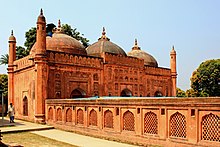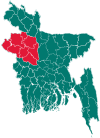Shibganj Upazila, Chapai Nawabganj
Shibganj Upazila
শিবগঞ্জ | |
|---|---|
 Darashbari Mosque | |
 | |
| Coordinates: 24°41′N 88°10′E / 24.683°N 88.167°E | |
| Country | |
| Division | Rajshahi |
| District | Chapai Nawabganj |
| Area | |
| • Total | 525.42 km2 (202.87 sq mi) |
| Population (2011) | |
| • Total | 591,178 |
| • Density | 1,100/km2 (2,900/sq mi) |
| Demonym | Shibganji |
| Time zone | UTC+6 (BST) |
| Website | Official Map of Shibganj |
Shibganj (Bengali: শিবগঞ্জ) is an upazila of Nawabganj District[1] in the Division of Rajshahi, Bangladesh.
History[edit]
Shibganj has a few well-known places with Hindu heritage, Kanshat town, and Kansat Bazar. Most of the wealthy Hindus left East Pakistan for India after Partition of India in 1947. One of Hindu families used to live by the side of the Shahanbandha lake or pookoor and the origin of village's name Pukhuria. The Hindu family was known as Ghosh family. Ghosh family had a manor by the side of the lake and surrounded on three sides by mango, coconut and date palm trees. This manor had an entrance with Ashoka trees. Ghosh family lived there for hundreds of years. Ramesh Chandra Ghosh was born there and studied at Malda Zilla School and Calcutta University and became a lawyer, after having MA LLB. He practiced law at Chapai Nawabganj of Malda District and later at Malda town. He was a politician and imprisoned by British colonial government of India during independence movements of the 1940s. He was a political colleague of Netaji Subhas Chandra Bose. Ramesh Chandra Ghosh married Shoilobala Sen of Coochbehar. The family of Shoilobala Sen was a friend of the then Maharaja of Cooch Behar. They had 4 sons and 2 daughters. Their eldest daughter was the first female who graduated (BA) from Calcutta University in that area. One son became principal of a college at Howrah near Kolkata, two sons became physician graduating from Kolkata NRS Medical College (formerly known as Campbell Medical College), and another became Chief Architect of Calcutta and had a postgraduate qualification from the United States. One of their physician sons went to UK and married an English lady and settled there and worked in UK National Health Service and had several achievements. He is mentioned in "Who's Who Indians in Britain."
Eldest daughter Manorama after graduating from Calcutta University was appointed Headmistress (Head Teacher) of Nawabganj Girls' High School and stayed there till the beginning of 1952. Four sons of Ramesh Chandra Ghosh were students of Nawabganj 'Harimohan High School' and passed Matriculation Examination with Scholarships and other achievements. Now the Ghosh family is spread to 4 continents of the world. There is a book being published in London about Pukhuria Village and Ghosh family and the offspring- "Once upon a time in a place in India". This book is about history of Pukhuria of last several hundred years and the Ghosh family. The book is compiled by Mailika Klaus, Grand Daughter-in-Law of Ramesh Chandra Ghosh and Soilobala Ghosh, who is European of Estonian origin and multilingual. One of the Grandsons of Ramesh Chandra Ghosh, Robin, is a Barrister in London and get mentioned in NewsPaper of London in his success in High Court/Crown Court cases. Other Grand children are high achievers in England, US, and Australia besides in India.
Geography[edit]

Shibganj is located at 24°41′00″N 88°10′00″E / 24.6833°N 88.1667°E. It has 124,899 households and a total area of 525.42 km2.
There is a land port and border checkpoint on the Bangladesh-India border at Sonamosjid[2]
Shibganj Upazila is bounded by Bholahat Upazila and English Bazar CD Block in Malda district, West Bengal, India on the north, Gomostapur, Nachole and Chapai Nawabganj Sadar Upazilas on the east, Chapai Nawabganj Sadar Upazila and Raghunathganj II CD Block in Murshidabad district, West Bengal, on the south and Kaliachak III CD Block, Malda district, on the west.[1][3][4]
Demographics[edit]
According to the 2011 Bangladesh census, Shibganj Upazila had 124,899 households and a population of 591,178. 137,004 (23.17%) were under 10 years of age. Shibganj had a literacy rate (age 7 and over) of 39.38%, compared to the national average of 51.8%, and a sex ratio of 1002 females per 1000 males. 49,833 (8.43%) lived in urban areas.[5][6]
As of the 1991 Bangladesh census, Shibganj has a population of 422,347. Males constitute 51.25% of the population, and females 48.75%. This upazila's eighteen up population is 203,072. Shibganj has an average literacy rate of 21.1% (7+ years), and the national average of 32.4% literate.[7]
Administration[edit]
Shibganj Upazila is divided into Shibganj Municipality and 15 union parishads: Binodpur, Chakkirti, Chhatrajitpur, Daipukuria, Dhainagar, Durlovpur, Ghorapakhia, Kansat, Mobarakpur, Monakasha, Noyalavanga, Panka, Shahbajpur, Shyampur, and Ujirpur. The union parishads are subdivided into 199 mauzas and 407 villages.[5]
Shibganj Municipality is subdivided into 9 wards and 31 mahallas.[5]
Chairman: SAYED NAZRUL ISLAM
Women Vice Chairman: Mrs. Shayema Begum
Vice Chairman: Shahidul Haqu Haidari
Upazila Nirbahi Officer (UNO): Irteza Hassan [1]
Library[edit]
There is a library named Akimuddin Gronthagar at Jaminpur. It contains a philosophy 'knowledge is entry'. The library was established on 4 May 2008. Within a year it worked very good with the students of science. Akimudin Gronthagar arranged three camps to observe the century's only total Solar eclipse of July 22, 2009.[8][9][10] It has more than 500 books and other tools and papers. It has a team led by Jahangir Alam Sur, science writer and enthusiast. The team arranges many program on science.
Notable people[edit]
- Khabeeruddin Ahmed, politician [11][12][13][14][15][16][17][18][19][excessive citations]
- Murtaza Raza Choudhry, former Finance Minister of East Bengal
- Mainur Reza Choudhury, Chief Justice Supreme Court of Bangladesh[20][citation needed]
- Mohammad Yusuf Siddiq, historian, epigraphist, researcher, professor and author
References[edit]
- ^ a b Md. Jalal Uddin Ahmed (2012). "Shibganj Upazila (Nawabganj District)". In Sirajul Islam; Miah, Sajahan; Khanam, Mahfuza; Ahmed, Sabbir (eds.). Banglapedia: the National Encyclopedia of Bangladesh (Online ed.). Dhaka, Bangladesh: Banglapedia Trust, Asiatic Society of Bangladesh. ISBN 984-32-0576-6. OCLC 52727562. OL 30677644M. Retrieved 30 April 2024.
- ^ "Land ports in brief" (PDF). Bangladesh government. Retrieved 15 November 2018.
- ^ "Tehsil Map of Murshidabad". CD Block/ Tehsil. Maps of India. Retrieved 15 November 2018.
- ^ "Tehsil Map of Maldah". CD Block/ Tehsil. Maps of India. Retrieved 15 November 2018.
- ^ a b c d "Bangladesh Population and Housing Census 2011 Zila Report – Chapai Nawabganj" (PDF). bbs.gov.bd. Bangladesh Bureau of Statistics.
- ^ "Community Tables: Chapai Nawabganj district" (PDF). bbs.gov.bd. Bangladesh Bureau of Statistics. 2011.
- ^ "Population Census Wing, BBS". Archived from the original on 2005-03-27. Retrieved November 10, 2006.
- ^ "Thousands watch long solar eclipse". The Daily Star. Archived from the original on 1999-04-23. Retrieved 2009-07-23.
- ^ "People watch century's last solar eclipse". bdnews24.com. Retrieved 2009-07-23.
- ^ "People watch century's last solar eclipse". Retrieved 2009-07-23.
- ^ Legislative Assembly Debates, Simla Feb 3 1921, p800-810
- ^ Legislative Assembly Debates, Vol III, Part I, p570, Government Central Press, 1922
- ^ "A New Party for Assembly". The Indian Express. 21 September 1936.
- ^ Major Elections, 1920–45, Schwartzberg Atlas, p222
- ^ John Venn and J. A. Venn, The Book of Matriculations and Degrees 1901-1912, the University of Cambridge, 2015
- ^ Archive of The Honorable Society of Gray's Inn
- ^ Legislative Assembly Debate, Vol 6, 1936, p334, New Delhi
- ^ Khabeeruddin family pleads for preservation of history
- ^ The Indian Annual Register, Vol 1, 1939, pp84, Gian Publishing House
- ^ Ebadul Hoque, Kazi (2012). "Chief Justice". In Sirajul Islam; Miah, Sajahan; Khanam, Mahfuza; Ahmed, Sabbir (eds.). Banglapedia: the National Encyclopedia of Bangladesh (Online ed.). Dhaka, Bangladesh: Banglapedia Trust, Asiatic Society of Bangladesh. ISBN 984-32-0576-6. OCLC 52727562. OL 30677644M. Retrieved 30 April 2024.
External links[edit]
 Gaud travel guide from Wikivoyage
Gaud travel guide from Wikivoyage

